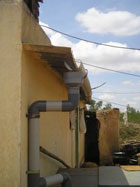Rainwater harvesting
With severe drought being experienced in several parts of the world, rainwater harvesting, an ancient technique is fast reemerging on the development sector front as a potential weapon for ‘water security’ of people, villages and industries.
Components of rainwater harvesting
Any rainwater harvesting system has three components
- Catchment
- Conveyance
- Storage
Rainwater harvesting is further categorized based on the catchment for the rainwater as rooftop rainwater harvesting, rainwater harvesting from paved and unpaved area called storm water harvesting, rainwater harvesting from water channels or streams called flood water harvesting
Catchment: Any surface can act as the catchment for rainwater harvesting. Rooftops are favoured because of the large coefficient of run-off generated from them and the relatively less likelihood of their contamination. Paved areas, footpaths and roads are also good rainwater runoff generators and with adequate catchment management strategies can provide good quantity and adequate quality of runoff water for use. Unpaved areas also generate runoff during heavy storms and can be modified to act as rainwater catchment.
Conveyance: Conveyance systems can be the catchment surface itself acting as a sheet runoff. For rooftops rainwater gutters and rainwater down pipes are conveyance systems, which need to be designed appropriately so as to manage the severest intensity of rain as well as not to lose any water during the conveyance process. Storm water drains, French drains with pebbles are also conveyance systems.
Storage: From the simplest ground level tank, to underground sumps, surface lined ponds and large lakes storage options are many depending on the context of the rainwater harvesting design.
In many a case the soil profile may also permit artificial recharge of rainwater to open wells and borewells where water can be stored to be retrieved later for productive use.
How to Harvest Rainwater?
- Collect water from the rooftop.
- Draw it down from pipes.
- Filter the water.
- Store in a sump or tank for later use.
- Charge the groundwater through a soak pit.
- Lead the water into a well to increase ground water content.


